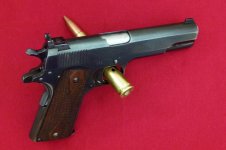Smithhound
US Veteran
Much good advice on this thread concerning shooting/collecting. Pred's especially re; the pre '24 time frame.
I both shoot and collect and have a rule I follow:
If I buy an older firearm in NIB condition, I keep it that way and try hard to find a shooter of the same type to use.
If I buy a vintage firearm that has seen use, I shoot it.
Using a fine old previously fired gun will not hurt it, abuse/neglect will kill it.
Personally tho, the thought of taking a 50 or 60 year old firearm in unfired condition out and shooting it makes me cringe. It's been in a time capsule for all those years and that, to me, is the way it should stay.
Others disagree, and that is fine, that's what makes this hobby great.
Enjoy, and post pics when you get it!
RD
I both shoot and collect and have a rule I follow:
If I buy an older firearm in NIB condition, I keep it that way and try hard to find a shooter of the same type to use.
If I buy a vintage firearm that has seen use, I shoot it.
Using a fine old previously fired gun will not hurt it, abuse/neglect will kill it.
Personally tho, the thought of taking a 50 or 60 year old firearm in unfired condition out and shooting it makes me cringe. It's been in a time capsule for all those years and that, to me, is the way it should stay.
Others disagree, and that is fine, that's what makes this hobby great.
Enjoy, and post pics when you get it!
RD





